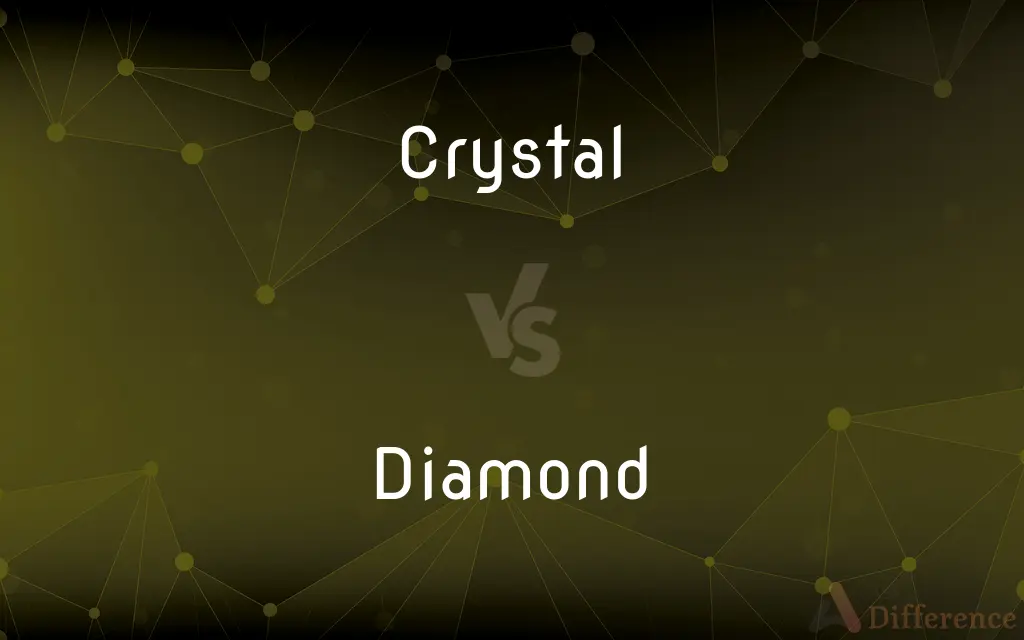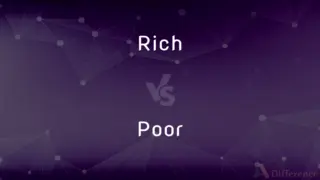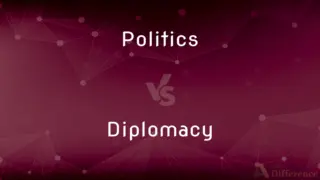Crystal vs. Diamond — What's the Difference?
By Maham Liaqat & Urooj Arif — Updated on April 18, 2024
A crystal is a solid material whose constituents are arranged in a highly ordered microscopic structure, forming a lattice that extends in all directions; a diamond is a specific type of crystal composed entirely of carbon atoms arranged in a dense.

Difference Between Crystal and Diamond
Table of Contents
ADVERTISEMENT
Key Differences
Crystals are defined by their structured patterns of atoms, ions, or molecules, which are organized in a repeating arrangement, resulting in various forms. On the other hand, diamonds are a specific kind of crystal made exclusively from carbon, distinguished by their extremely strong and rigid lattice.
The term "crystal" can refer to substances ranging from simple salts like sodium chloride to complex silicates in rocks. Whereas diamonds are a particular variety of crystal with unique properties such as extraordinary hardness and high refractive indices, making them particularly valuable both industrially and as gemstones.
All diamonds are crystals, but not all crystals are diamonds. This distinction is crucial because it highlights the specificity of diamonds within the broader category of crystalline substances. In contrast, the term "crystal" encompasses a wide variety of substances with crystalline structures.
The formation of a crystal can occur in various conditions, typically from solutions or melts as they cool. Diamonds specifically form under high-pressure, high-temperature conditions deep within the Earth’s mantle, and are brought to the surface through volcanic activity.
In practical applications, crystals are used in a multitude of technologies, including electronic components, optical instruments, and decoration. Diamonds, due to their hardness, are used in cutting, drilling, or grinding tools, and are also highly sought after in the jewelry market.
ADVERTISEMENT
Comparison Chart
Composition
Various atoms, ions, or molecules
Pure carbon
Structure
Repeating atomic arrangement
Tetrahedral carbon atom arrangement
Hardness
Varies widely
Extremely hard (hardest natural material)
Formation
Typically from cooling solutions/melts
High-pressure, high-temperature conditions
Uses
Electronics, optics, decoration
Cutting tools, jewelry
Optical Properties
Variable transparency and refraction
High refractive index and dispersion
Compare with Definitions
Crystal
A solid in which the atoms are arranged in a precise repeating pattern extending in all three spatial dimensions.
Quartz crystals are used in watches because of their precise oscillations.
Diamond
Exhibits high optical dispersion, making it highly valuable as a gemstone.
The sparkling of a diamond ring is due to its high dispersion of light.
Crystal
Naturally occurring or synthetically produced solid with a definite form due to the ordered arrangement of its particles.
Salt crystals often form as water evaporates from a solution.
Diamond
A form of carbon with its atoms arranged in a robust tetrahedral lattice.
Diamonds are prized in jewelry for their unmatched brilliance and durability.
Crystal
Visible crystalline structures are often admired for their beauty and complexity.
Snowflakes are unique examples of natural crystal patterns.
Diamond
The hardest known natural material, used extensively in industrial applications.
Diamond-tipped drills are used for cutting through hard rock.
Crystal
Any substance whose atoms are arranged in a crystalline structure.
Ice forms crystals when water freezes.
Diamond
Formed under extreme pressure and temperature conditions deep within the Earth.
Diamonds are mined from kimberlite pipes where they have been brought to the Earth’s surface by volcanic activity.
Crystal
Used broadly in various scientific and industrial applications due to diverse properties.
Silicon crystals are fundamental in manufacturing computer chips.
Diamond
Often symbolizes wealth, durability, and status.
Diamond necklaces are a popular luxury gift for significant occasions.
Crystal
A crystal or crystalline solid is a solid material whose constituents (such as atoms, molecules, or ions) are arranged in a highly ordered microscopic structure, forming a crystal lattice that extends in all directions. In addition, macroscopic single crystals are usually identifiable by their geometrical shape, consisting of flat faces with specific, characteristic orientations.
Diamond
Diamond is a form of the element carbon with its atoms arranged in a crystal structure called diamond cubic. At room temperature and pressure, another solid form of carbon known as graphite is the chemically stable form of carbon, but diamond almost never converts to it.
Crystal
A piece of a homogeneous solid substance having a natural geometrically regular form with symmetrically arranged plane faces
Ice crystals formed where his breath froze
A quartz crystal
Diamond
A precious stone consisting of a clear and colourless crystalline form of pure carbon, the hardest naturally occurring substance
A diamond ring
Crystal
Highly transparent glass with a high refractive index
A crystal chandelier
Diamond
A figure with four straight sides of equal length forming two opposite acute angles and two opposite obtuse angles; a rhombus
A sweater with a pale-blue diamond pattern
Crystal
Short for crystal meth (methamphetamine)
Diamond
An extremely hard, highly refractive crystalline form of carbon that is usually colorless and is used as a gemstone and in abrasives, cutting tools, and other applications.
Crystal
Clear and transparent like crystal
The clean crystal waters of the lake
Diamond
A piece of jewelry containing such a gemstone.
Crystal
A homogenous solid formed by a repeating, three-dimensional pattern of atoms, ions, or molecules and having fixed distances between constituent parts.
Diamond
A rhombus, particularly when oriented so that one diagonal extends from left to right and the other diagonal extends from top to bottom.
Crystal
The unit cell of such a pattern.
Diamond
A red, lozenge-shaped figure on certain playing cards.
Crystal
A mineral, especially a transparent form of quartz, having a crystalline structure, often characterized by external planar faces.
Diamond
A playing card with this figure.
Crystal
A natural or synthetic crystalline material having piezoelectric or semiconducting properties.
Diamond
Diamonds (used with a sing. or pl. verb) The suit of cards represented by this figure.
Crystal
An electrical or electronic device that makes use of such a material, thereby allowing it to receive radio transmissions.
Diamond
The infield.
Crystal
A high-quality, clear, colorless glass.
Diamond
The whole playing field.
Crystal
An object, especially a vessel or ornament, made of such glass.
Diamond
Of or relating to a 60th or 75th anniversary.
Crystal
Such objects considered as a group.
Diamond
To adorn with diamonds.
Crystal
A clear glass or plastic protective cover for the face of a watch or clock.
Diamond
(uncountable) A glimmering glass-like mineral that is an allotrope of carbon in which each atom is surrounded by four others in the form of a tetrahedron. Category:en:Carbon
The saw is coated with diamond.
Crystal
(Slang) A stimulant drug, usually methamphetamine, in its powdered form.
Diamond
A gemstone made from this mineral.
The dozen loose diamonds sparkled in the light.
Crystal
Clear or transparent
A crystal lake.
The crystal clarity of their reasoning.
Diamond
A ring containing a diamond.
What a beautiful engagement diamond.
Crystal
(countable) A solid composed of an array of atoms or molecules possessing long-range order and arranged in a pattern which is periodic in three dimensions.
Diamond
A very pale blue color.
Crystal
(countable) A piece of glimmering, shining mineral resembling ice or glass.
Diamond
Something that resembles a diamond.
Crystal
(uncountable) A fine type of glassware, or the material used to make it.
Diamond
(geometry) A rhombus, especially when oriented so that its longer axis is vertical.
Crystal
Crystal meth: methamphetamine hydrochloride.
Diamond
(geometry) The polyiamond made up of two triangles.
Crystal
A person's eye.
Diamond
(baseball) The entire field of play used in the game.
Crystal
The glass over the dial of a watch case.
Diamond
(baseball) The infield of a baseball field.
The teams met on the diamond.
Crystal
Very clear.
"Do I make myself clear?" / "Crystal."
Diamond
(card games) A card of the diamonds suit.
I have only one diamond in my hand.
Crystal
The regular form which a substance tends to assume in solidifying, through the inherent power of cohesive attraction. It is bounded by plane surfaces, symmetrically arranged, and each species of crystal has fixed axial ratios. See Crystallization.
Diamond
A size of type, standardised as 2 point.
Crystal
The material of quartz, in crystallization transparent or nearly so, and either colorless or slightly tinged with gray, or the like; - called also rock crystal. Ornamental vessels are made of it. Cf. Smoky quartz, Pebble; also Brazilian pebble, under Brazilian.
Diamond
The size of type between brilliant and pearl, standardized as 2-point.
Crystal
A species of glass, more perfect in its composition and manufacture than common glass, and often cut into ornamental forms. See Flint glass.
Diamond
Made of, or containing diamond, a diamond or diamonds.
He gave her diamond earrings.
Crystal
The glass over the dial of a watch case.
Diamond
Of, relating to, or being a sixtieth anniversary.
Today is their diamond wedding anniversary.
Crystal
Anything resembling crystal, as clear water, etc.
The blue crystal of the seas.
Diamond
Of, relating to, or being a seventy-fifth anniversary.
Today is their diamond wedding anniversary.
Crystal
Consisting of, or like, crystal; clear; transparent; lucid; pellucid; crystalline.
Through crystal walls each little mote will peep.
By crystal streams that murmur through the meads.
The crystal pellets at the touch congeal,And from the ground rebounds the ratting hail.
Diamond
(slang) First-rate; excellent.
He's a diamond geezer.
Crystal
A solid formed by the solidification of a chemical and having a highly regular atomic structure
Diamond
To adorn with or as if with diamonds
Crystal
A crystalline element used as a component in various electronic devices
Diamond
A precious stone or gem excelling in brilliancy and beautiful play of prismatic colors, and remarkable for extreme hardness.
Crystal
A rock formed by the solidification of a substance; has regularly repeating internal structure; external plane faces
Diamond
A geometrical figure, consisting of four equal straight lines, and having two of the interior angles acute and two obtuse; a rhombus; a lozenge.
Crystal
Colorless glass made of almost pure silica
Diamond
One of a suit of playing cards, stamped with the figure of a diamond.
Crystal
Glassware made of quartz
Diamond
A pointed projection, like a four-sided pyramid, used for ornament in lines or groups.
Crystal
A protective cover that protects the face of a watch
Diamond
The infield; the square space, 90 feet on a side, having the bases at its angles.
Diamond
The smallest kind of type in English printing, except that called brilliant, which is seldom seen.
Diamond
Resembling a diamond; made of, or abounding in, diamonds; as, a diamond chain; a diamond field.
Diamond
A transparent piece of diamond that has been cut and polished and is valued as a precious gem
Diamond
Very hard native crystalline carbon valued as a gem
Diamond
A playing card in the minor suit of diamonds
Diamond
The area of a baseball field that is enclosed by 3 bases and home plate
Diamond
The baseball playing field
Common Curiosities
What defines a diamond?
A diamond is a crystalline form of carbon, recognized for its tetrahedral arrangement of atoms and extreme hardness.
What is the basic definition of a crystal?
A crystal is a solid where the atoms are arranged in an orderly repeating pattern, extending in all three dimensions.
What are the typical uses of crystals?
Crystals are used in a variety of applications including electronics, optical devices, and as decorative items.
What makes diamonds valuable?
Diamonds are valued for their physical properties such as hardness and optical qualities, as well as their rarity and symbolic significance.
Where do diamonds typically form?
Diamonds form under high-pressure and high-temperature conditions in the Earth’s mantle and are brought to the surface by volcanic activity.
What is the difference in hardness between crystals and diamonds?
The hardness varies among crystals, but diamonds are the hardest known natural material.
Are all diamonds crystals?
Yes, all diamonds are a type of crystal, specifically formed from carbon.
Can all crystals be considered diamonds?
No, only crystals composed of carbon with a specific tetrahedral structure are considered diamonds.
How do crystals form naturally?
Crystals typically form when liquid solutions cool and start to harden, with atoms arranging in a structured pattern.
What are the optical properties of diamonds compared to other crystals?
Diamonds have a high refractive index and dispersion, making them uniquely brilliant compared to other crystals.
Share Your Discovery

Previous Comparison
Rich vs. Poor
Next Comparison
Politics vs. DiplomacyAuthor Spotlight
Written by
Maham LiaqatCo-written by
Urooj ArifUrooj is a skilled content writer at Ask Difference, known for her exceptional ability to simplify complex topics into engaging and informative content. With a passion for research and a flair for clear, concise writing, she consistently delivers articles that resonate with our diverse audience.
















































